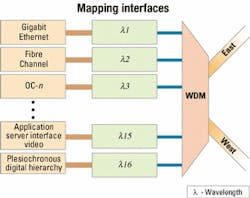Simplicity and reliability of multiservice platforms
PAUL ZALLOUA, LuxN
Networks are built to transport applications on top of them or provide services to end users. The simplest form of a service or an application is a phone call. Making a phone call from home or from the office is as natural and as easy as brewing a cup of coffee in the morning-perhaps easier. Whenever we pick up the phone handset, we know with 99.99% certainty that we'll get a dial tone, and that once we complete the dialing, the phone on the other side of the line will begin to ring within few seconds. If we are lucky, the called person will pick up the phone and a conversation, important or not, will be transported between two points in the network in the most reliable way.
Of course, if we are less fortunate, an answering machine or a voice-mail system takes on the responsibility of greeting, concluding the voice applications within seconds. This simplicity and reliability is the goal for all services, including high-bandwidth data services. Clearly we are miles away from reaching such a paradigm. But are we getting closer? Of course we are.
Today, placing a call into the Internet can be as simple as turning on our computer. The challenge is heightened in the enterprise world where high-bandwidth services with different flavors, interfaces, and underlying technologies for business connectivity are needed. In this case, it is high-stake business. Enterprise customers shelling out $10,000 per month per multimegabit service expect simplicity in the connectivity of the service and high reliability in its operation.
Underneath the simplicity of delivering voice line services lies a high degree of complexity in network design, architecture, and operation. It is that complexity that makes the current PSTN reliable. After traversing the local access loop and metamorphosing into a digital representation, a typical coast-to-coast voice circuit will touch at least four distinct network elements, including add/drop multiplexers (ADMs) deployed at the SONET/SDH subtending rings, higher-order ADMs used in the SONET/SDH backbone rings, digital crossconnects, and in some cases, DWDM equipment.A high-bandwidth data service such as OC-12/STM-4 (622-Mbit/sec) packet-over-SONET (PoS) traverses additional equipment including IP routers and ATM switches. Each discrete network element adds complexity to the operation-and the more high-bandwidth data-centric services are offered, the more complex their transport operation becomes.
It is the deployment of fiber-based SONET/SDH architecture in access and backbone WANs that enabled the high reliability and 99.99% call completion rate of current telephony services through the PSTN. Hence, the complex operations of such networks are justified. With close to 20 years of deployment history, SONET/SDH networks provide the highest level of reliability available today in the telecommunications world.
Voice and data services, as long as they are presented in a TDM-based fashion, are being reliably transported over the network. SONET/SDH has a great affinity to TDM, as long as services are mapped within the SONET/SDH frames.
The picture changed as service providers started tackling the challenge of transporting Ethernet and IP traffic across their existing SONET/SDH infrastructures. Definition of reliability within an enterprise network, with the exception of financial institutions networking, differs substantially from the one adopted in the carrier world. Cost and complexity of SONET/SDH is not at all attractive in a world dominated by Ethernet and IP.
The Ethernet protocol assumes an unreliable medium and hence relies on a higher networking layer, such as transmission control protocol for traffic integrity and reliability. Transporting Ethernet/IP traffic across WANs has always been a challenge for both service providers and enterprise customers. Ethernet traffic does not gracefully map onto the reliable, yet complex, SONET/SDH infrastructure. Numerous solutions came to the rescue-some were proposed, others were adopted, deployed, and later abandoned.First came frame relay, mapping packets onto frames and frames onto plesiochronous digital hierarchy (PDH) signals, such as DS-1 (1.5 Mbits/sec) and DS-3 (45 Mbits/sec), which were then multiplexed onto SONET/SDH. Next came ATM, mapping packets and other types of traffic onto cells.
At first, ATM appeared to provide a unified platform upon which service providers could integrate different types of services to offer value-added services, such as traffic bursting, traffic prioritization, and bandwidth-on-demand. These ATM-based services are transported over the existing SONET/SDH infrastructure, ensuring high service availability and reliability.
But ATM as a technology was inherently complex and its demise was in that complexity. With the ATM-based multiservice platforms abandoned, another Ethernet/IP mapping interface was needed. PoS assumed the role of interfacing an IP router to the SONET/SDH network.
With PoS, high-bandwidth services are offered at different SONET/SDH rates. Though the mapping is not quite efficient, these services are being deployed on top of the existing SONET/SDH infrastructure, offering a stopgap for service providers until a true optical-based multiservice platform is put in place. SONET/SDH hierarchy is not really optimized for transporting large data transfers and cannot cost-effectively absorb a high number of OC-N PoS services.
WDM has been deployed underneath the SONET/SDH layer to expand the network capacity in terms of bandwidth. In such networks, SONET/SDH becomes a single wavelength interface, unaware of the underlying WDM transport layer. Service providers are forced to manage three discrete networks to offer a single high-bandwidth IP service, including the Layer 2 and 3 mapping to SONET/SDH interfaces, SONET/SDH equipment, and point-to-point WDM systems. That makes it costly for service providers to offer the same degree of availability and reliability they would provide for basic PDH services.Offering high-bandwidth services is not limited to IP traffic transport. Other bandwidth-hungry applications, such as storage and legacy video streaming, must be transported across the metro and even the core network. Wavelength-based services can be offered, providing transport of Fibre Channel, Ficon and Escon, and video DVD-access server integration.
With transparent wavelength services, transport of native IP traffic is efficiently achieved without the need of extensive and complex mapping of IP packets onto SONET/SDH frames. Fast Ethernet, Gigabit Ethernet, and soon 10-Gigabit Ethernet interfaces can be natively mapped onto wavelength-based services. Such solutions offer simplicity in network architecture while enhancing the reliability of the multiservice delivery platform.
While service providers are aiming continuously at reducing the total cost of ownership of service deployment, such solutions are quickly appearing to be inefficient-not only in terms of bandwidth use, but also in the extensive management coordination required between the multiple network layers. The cost of maintaining the same level of service availability and reliability increases exponentially as more equipment is used to deliver a service.
Service providers need a cost-effective service-delivery platform upon which high-bandwidth services are offered without the need for mapping each type of service mix onto SONET/SDH. Such a platform should provide all the necessary functions to transport a service most reliably and efficiently at any rate. That could be achieved by insisting on simplicity in the architecture.
Functions like traffic transport, resiliency, multiplexing, monitoring, and maintenance must be supported while leaving IP routing, Layer 2/3, and ATM switching to other specialized equipment optimized by design to perform such functions. Platforms combining transport and service functions yield complex and costly architecture with cumbersome operations. Simplicity is the key to the success of any high-bandwidth multiservice delivery platform.
The shortcomings of the installed SONET/SDH-based networks in terms of transporting high-bandwidth services are becoming more and more evident with the increase in demand for such transport services. Besides the high degree of resiliency and reliability SONET/SDH networks are providing, they are failing to transport native traffic generated at customer premises.
It is naÏve to think SONET/SDH networks will disappear in the near future. Gradually, SONET/SDH networks become an overlay layer on top of the WDM transport layer. In this scenario, SONET/SDH becomes an interface that is mapped transparently onto a wavelength. Resiliency is then provided at the optical layer where optical-based unidirectional path-switched rings and optical-based bidirectional line-switched rings are implemented to provide path protection for transport links carrying high wavelength counts.
The service-delivery network architecture will consist of two major functions-service and transport. It is at the service layer where service-specific functionalities are implemented. Disparate network elements may exist at that level. The transport function will be responsible for mapping these services onto light-more specifically onto different wavelengths. It is at the transport layer where effective integration of WDM, service aggregation, and crossconnect and transport resiliency occurs.
An optical multiservice platform acting as a gateway between the services layer and the physical transport is necessary. Functions such as service mapping, WDM, and transport of various interfaces and protocols at several bit rates over the metro and regional physical infrastructure are provided. Optical add/drop, amplification, and other optical transport functionalities can also be provided while maintaining the simplicity of the architecture.
The optical multiservice platform must provide the same level of resiliency and reliability offered over the SONET/SDH transport networks. With the transport of gigabits of bandwidth services, service providers require a high level of network availability to fulfill their customer service contracts.
Highest levels of reliability are attained through a combination of simple architecture, best-of-breed products at each layer of the network, the use of high-quality components, infant mortality testing, and redundancy with associated path and hardware protection switching. As is the case in SONET/SDH, service providers will be looking for self-healing WDM rings on two- and four-fiber ring facilities.
Protection switching mechanisms, such as path, line, and shared protection switching, complemented with enough electronic and optoelectronic redundancy in the form of hot standby and hot-swappable modules, are a requirement for any optical multiservice platform. In addition, protection switching must be provided on a wavelength-per-service or -per-fiber basis.
Minimization of service downtime and service reconfiguration is crucial for speeding up service provisioning. Within the SONET/SDH infrastructure, connecting two locations in a metro area or between two cities requires some traffic engineering. First, one must determine with some degree of certainty the maximum bandwidth requirements. An additional 30% of the bandwidth should be added for contingency purposes before the total capacity is determined. With a WDM-based service platform, services and bandwidth are added on an as-needed basis, and the provisioning of such an addition is accomplished by adding the associated hardware at both service endpoints.
Perhaps the biggest challenge with optical-based service delivery platforms is traffic monitoring and fault isolation. Once traffic enters the optical domain, traffic information metamorphoses into photons. With current optical technologies, manipulating photons to deduce the integrity or validity of traffic is quite impossible.
Monitoring requires converting the photons into electrical signals and interpreting these signals-but even that alone may not be enough. In order for optical-based WDM networking systems to be deployed in a service-provider environment, traffic monitoring and fault isolation capabilities must be at par with SONET/SDH monitoring methods.
Using section, line, and path monitoring domains, traffic is observed at every junction of the SONET/SDH network. Anomaly, defect, and failure are rapidly identified, localized, and reported to a higher management layer. The SONET/SDH protocol provides intrinsic traffic monitoring capabilities, such as identification of discrepancies between observed and desired traffic characteristics, service interruption, bit-error measurements, and parity errors. It does that in the electrical domain since traffic payload of services is accessed at every network node.
Extensive overhead information is added to the SONET/SDH traffic payload to achieve these monitoring and fault isolation capabilities. Services of any kind or any speed must be mapped into a SONET/SDH payload to apply these monitoring capabilities and take advantage of SONET/SDH reliability and resiliency. That may be a simple effort with PDH-based services. But with other services, such as native LAN connectivity, storage, or streaming video, optimized mapping cannot be achieved.
Is there a way to non-intrusively provide service traffic monitoring and fault isolation, independent of protocol, rate, or interface? Can it be done at the optical transport layer?
The answer is a resounding "yes"-with a technique called analog symbol monitoring (ASM). ASM is capable of measuring the bit-error rate of a transmission link by quantitatively measuring the analog symbol representation of the signal. ASM can be used to enhance, or complement, the performance monitoring capabilities of SONET/SDH and other protocols.
ASM performance monitoring involves tapping the electrical analog signal prior to quantization, unlike SONET/SDH, which occurs after quantization. Any degradation of the optical transmission due to attenuation, dispersion, or non-linear effects will alter the characteristics of the received analog symbols and be detected. Using post-processing logic circuitry, user-set threshold levels can be configured so any violations of these thresholds will trigger an alarm event.
Similar to SONET/SDH, ASM provides an optical channel with in-service, non-intrusive monitoring capabilities. This attribute dramatically increases service providers' ability to monitor their network down to the bit level. Moreover, ASM can be used with other performance monitoring techniques that use bit-sequence calculations, as long as ASM is administered prior to bit sequence.
Multiservice platforms based on optical-networking technologies such as WDM provide significant flexibility for service providers that require migration beyond legacy telephony-based SONET/SDH. That is especially true when new service capabilities of data and video are added. The use of WDM networking eliminates costly and inefficient conversions from native protocols into SONET/SDH.
However, native transport alone is not the answer. Technologies like optical protection switching and ASM are required to provide resiliency and monitoring capabilities, respectively. Implementing an optical multiservice platform can provide dramatic savings to service providers.
Paul Zalloua is assistant vice president of product development at LuxN (Sunnyvale, CA). He can be reached via the company's Website, www.luxn.com.




